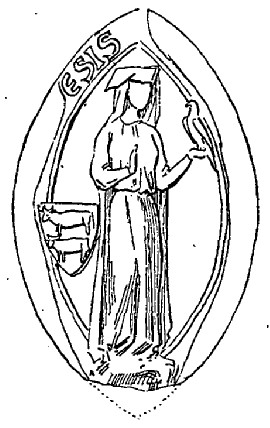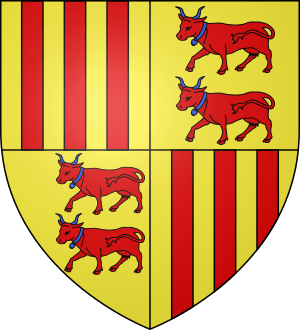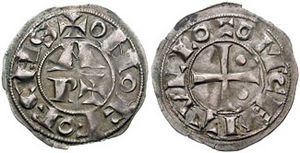Margaret of Béarn facts for kids
Quick facts for kids
Margaret of Béarn
|
|
|---|---|

Early tribute to Margaret
|
|
| Born | c. 1245–1250 |
| Died | c. 1319 |
| Nationality | French |
| Other names | Margaret of Montcada, Marguerite of Montcada |
| Occupation | Viscountess, Countess |
| Spouse(s) | Roger-Bernard III of Foix (1240 – 1303) |
| Children | Gaston I, Constance, Mathe, Marguerite, Brunissende |
| Parents |
|
Margaret of Béarn, also known as Margaret of Montcada, was born around 1245–1250 and died around 1319. She was a powerful noblewoman. She ruled lands near the Pyrenees mountains. These lands are now in southwestern France. She ruled with her husband or for her young son.
When her father died in 1290, she became the Viscountess of Béarn. This meant she inherited his lands and title. Later, in 1310, her sister died. Margaret then became the Countess of Bigorre.
Contents
Margaret's Family Background
Margaret came from a very important noble family. Her father was Gaston VII, Viscount of Béarn. Her mother was Martha, Viscountess of Marsan, who was also the Countess of Bigorre.
Margaret had three sisters:
- Constance (died 1310) became Countess of Bigorre after their mother. She married three times. Her first husband was Alfonso, a prince from Aragon.
- Martha married Gerald VI, Count of Armagnac in 1260.
- Guillelme (died 1309) was engaged to Sancho IV of Castile. Later, she married Peter of Aragon.
Her Marriage and Children
Margaret's marriage was planned when she was only about seven years old. The agreement was signed in October 1252. It said she would marry Roger-Bernard III of Foix. He was born in 1240 and died in 1303.
The wedding finally happened fifteen years later, in 1267. This marriage was very good for politics. It created a strong team between the House of Béarn and the House of Foix.
Margaret and Roger-Bernard had five children:
- Gaston I (1287 – 1315) inherited many titles. He became Count of Foix and Viscount of Béarn.
- Constance married John I de Lévis in 1296.
- Mathe married Gerard VI of Armagnac in 1294.
- Marguerite married Bernard IV Jordan of L'Isle-Jourdain in 1291. She died in 1304.
- Brunissende married Elias VII of Périgord in 1298.
Becoming a Ruler
In 1290, Margaret's father died. She inherited a lot of land and became the Viscountess of Béarn. She shared this role with her husband. She held this title until 1310. That year, her sister Constance died. Margaret then became the Countess of Bigorre. She held this title until she died.
Taking over Béarn was not easy. Margaret's father, Gaston VII, Viscount of Béarn, first said Margaret would be his heir. Most people accepted this. But her sister Mathe and her husband, Gerald VI, Count of Armagnac, did not agree.
Later, before he died, Margaret's father changed his mind. He said another daughter, Guillemette, should be the heir. But when he died in 1290, Margaret's husband, Roger-Bernard, quickly took control of the lands for her. To show his power, Roger-Bernard changed the family's coat of arms. It now combined designs from both Foix and Béarn. Roger-Bernard strongly supported his wife's claims to the land for his whole life.
In 1293, Margaret's brother-in-law, Gerard VI (Mathe's husband), challenged her claim to Béarn. This started a long war between him and Roger-Bernard. The war was about which sister had the right to the land.
When Roger-Bernard died in 1303, Margaret became the regent for her son, Gaston I, Count of Foix. Gaston was only 13 years old. Margaret ruled Foix until her son was old enough to take over.
Béarn's History After Margaret
During Margaret's time, Béarn was an independent area. It had its own coins and its own language. This language was a local version of Old Occitan called the Bearnès dialect. Sometimes, Béarn grew to include Andorra and parts of the Basque Country. These areas are now in northern Spain and southern France.
Because Béarn was independent, other countries tried to take it over for many centuries. Finally, in 1620, France took control. King Louis XIII marched into Béarn with a large army. He took the nobles' lands. Then, sitting on his new Béarnese throne, he declared that Béarn was now part of France. This ended Béarn's independence.



